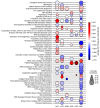Glucose Metabolism and Aging of Hematopoietic Stem and Progenitor Cells
- PMID: 35328449
- PMCID: PMC8955027
- DOI: 10.3390/ijms23063028
Glucose Metabolism and Aging of Hematopoietic Stem and Progenitor Cells
Abstract
Comprehensive proteomics studies of human hematopoietic stem and progenitor cells (HSPC) have revealed that aging of the HSPC compartment is characterized by elevated glycolysis. This is in addition to deregulations found in murine transcriptomics studies, such as an increased differentiation bias towards the myeloid lineage, alterations in DNA repair, and a decrease in lymphoid development. The increase in glycolytic enzyme activity is caused by the expansion of a more glycolytic HSPC subset. We therefore developed a method to isolate HSPC into three distinct categories according to their glucose uptake (GU) levels, namely the GUhigh, GUinter and GUlow subsets. Single-cell transcriptomics studies showed that the GUhigh subset is highly enriched for HSPC with a differentiation bias towards myeloid lineages. Gene set enrichment analysis (GSEA) demonstrated that the gene sets for cell cycle arrest, senescence-associated secretory phenotype, and the anti-apoptosis and P53 pathways are significantly upregulated in the GUhigh population. With this series of studies, we have produced a comprehensive proteomics and single-cell transcriptomics atlas of molecular changes in human HSPC upon aging. Although many of the molecular deregulations are similar to those found in mice, there are significant differences. The most unique finding is the association of elevated central carbon metabolism with senescence. Due to the lack of specific markers, the isolation and collection of senescent cells have yet to be developed, especially for human HSPC. The GUhigh subset from the human HSPC compartment possesses all the transcriptome characteristics of senescence. This property may be exploited to accurately enrich, visualize, and trace senescence development in human bone marrow.
Keywords: aging; central carbon metabolism; glycolysis; hematopoietic stem and progenitor cells; senescence signature.
Conflict of interest statement
The authors declare no conflict of interest.
Figures



Similar articles
-
A Senescent Cluster in Aged Human Hematopoietic Stem Cell Compartment as Target for Senotherapy.Int J Mol Sci. 2025 Jan 17;26(2):787. doi: 10.3390/ijms26020787. Int J Mol Sci. 2025. PMID: 39859500 Free PMC article.
-
Glycogen accumulation, central carbon metabolism, and aging of hematopoietic stem and progenitor cells.Sci Rep. 2020 Jul 14;10(1):11597. doi: 10.1038/s41598-020-68396-2. Sci Rep. 2020. PMID: 32665666 Free PMC article.
-
Aging-Related Reduced Expression of CXCR4 on Bone Marrow Mesenchymal Stromal Cells Contributes to Hematopoietic Stem and Progenitor Cell Defects.Stem Cell Rev Rep. 2020 Aug;16(4):684-692. doi: 10.1007/s12015-020-09974-9. Stem Cell Rev Rep. 2020. PMID: 32418119 Free PMC article.
-
Hematopoietic Niche - Exploring Biomimetic Cues to Improve the Functionality of Hematopoietic Stem/Progenitor Cells.Biotechnol J. 2018 Feb;13(2). doi: 10.1002/biot.201700088. Epub 2017 Dec 28. Biotechnol J. 2018. PMID: 29178199 Review.
-
Hematopoietic Stem Cells: Normal Versus Malignant.Antioxid Redox Signal. 2018 Dec 1;29(16):1612-1632. doi: 10.1089/ars.2017.7326. Epub 2017 Dec 20. Antioxid Redox Signal. 2018. PMID: 29084438 Free PMC article. Review.
Cited by
-
Lysosomes and Their Role in Regulating the Metabolism of Hematopoietic Stem Cells.Biology (Basel). 2022 Sep 27;11(10):1410. doi: 10.3390/biology11101410. Biology (Basel). 2022. PMID: 36290314 Free PMC article. Review.
-
Monocytes in allo-HSCT with aged donors secrete IL-1/IL-6/TNF to increase the risk of GVHD and damage the aged HSCs.iScience. 2024 Feb 6;27(3):109126. doi: 10.1016/j.isci.2024.109126. eCollection 2024 Mar 15. iScience. 2024. PMID: 38405615 Free PMC article.
-
A Senescent Cluster in Aged Human Hematopoietic Stem Cell Compartment as Target for Senotherapy.Int J Mol Sci. 2025 Jan 17;26(2):787. doi: 10.3390/ijms26020787. Int J Mol Sci. 2025. PMID: 39859500 Free PMC article.
-
Cerebral Microvascular Senescence and Inflammation in Diabetes.Front Physiol. 2022 Apr 29;13:864758. doi: 10.3389/fphys.2022.864758. eCollection 2022. Front Physiol. 2022. PMID: 35574460 Free PMC article. Review.
References
Publication types
MeSH terms
Substances
Grants and funding
LinkOut - more resources
Full Text Sources
Medical
Research Materials
Miscellaneous

